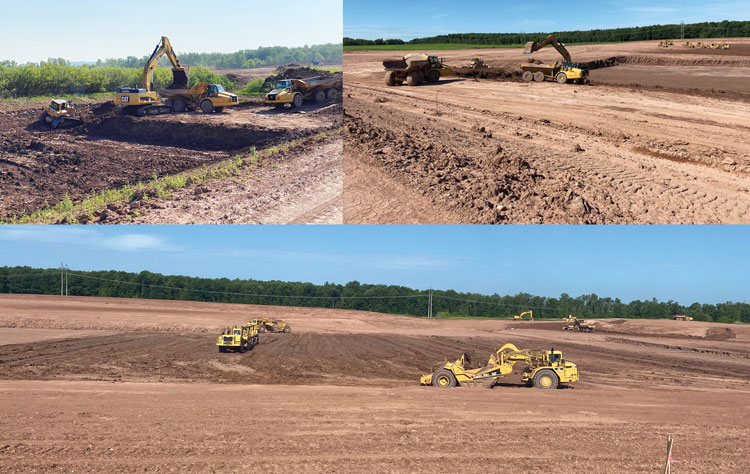Shortly after the Outagamie County landfill began accepting waste, Brown County began the process to make sure that its landfill would be ready when the Outagamie County facility was filled. Construction of the Brown County landfill, in the town of Holland, began in spring 2020 and will be ready to accept waste by December 2021.
By Chad Doverspike
Working cooperatively can produce benefits, particularly when looking at economies of scale. That is the whole idea behind the BOW—the solid waste and recycling partnership among Brown, Outagamie and Winnebago counties in Wisconsin. The BOW partnership has been in place since 2003 and includes a 25-year cooperative landfill agreement to jointly use each other’s landfill space.
When the BOW took effect in 2003, the first landfill to take waste from all three counties was located in Outagamie County, then transitioned to an open landfill in Winnebago County. When that landfill reached capacity, the waste disposal was shifted to a second landfill in Outagamie County. With the Outagamie County landfill expected to reach capacity in 2023, the Brown County South Landfill is next in line as the landfill host.
Developing the Brown County South Landfill
Siting a new landfill typically takes up to 10 years to complete. There is a stringent review and approval process through the Wisconsin Department of Natural Resources (WDNR). In the case of the Brown County South Landfill, this process started decades earlier before the three counties had developed their cooperative waste agreement. Shortly after the Outagamie County landfill began accepting waste, Brown County began the process to make sure that its landfill would be ready when the Outagamie County facility was filled. Construction of the Brown County landfill, in the town of Holland, began in spring 2020 and will be ready to accept waste by December 2021.

Throughout the planning process for the South Landfill, the Brown County Port & Resource Recovery Department has and will continue to work closely with the town of Holland and nearby residents. Brown County Resource Recovery staff have listened carefully to the concerns from the community while addressing any impacts to the area and those surrounding the landfill. The number one goal is to provide a service to local municipalities and businesses that is both economically safe and environmentally responsible.
The South Landfill design consists of a 4-foot thick clay liner, overlain with a high-density polyethylene geomembrane liner and protective geotextile. This design also features extensive environmental protection features, which include a composite liner and cap system, a groundwater gradient control system, a landfill gas management system, and a leachate collection and management system. The leachate collection system will be directed to a single collection point within each phase of the landfill’s construction, which will then be collected and hauled via a tanker truck to a direct discharge point within the regional (NEW Water) wastewater management system. The final cover system of the landfill will consist of a 2-foot thick clay layer overlain with a textured geomembrane layer, a geo-composite drainage layer, a rooting-zone layer and topsoil.
The South Landfill phase 1 construction project will cost around $23 million, with annual operating costs expected to be $12 million to $13 million. Brown County’s goal is not only to meet existing code requirements but to exceed them. Brown County Resource Recovery has implemented monitoring systems to track groundwater monitoring wells, leachate quality monitoring, leachate head wells, landfill gas monitoring probes and stormwater monitoring plans.
In the meantime, everyone involved with the creation and management of the new landfill is also looking towards the future in ways to provide alternative forms of energy and become even more environmentally friendly. One possibility for the South Landfill is to convert landfill gas into natural gas to reduce energy costs onsite and to sell offsite.
Economical and Environmentally Responsible
With a strong emphasis on recycling, some have questioned the need to continue landfilling waste. While reducing the amount of waste being sent to landfills is a long-term goal of the BOW, it is important to note that landfills are still the most economical and environmentally responsible means of handling waste especially for material that does not have markets.
Brown County Resource Recovery and its partners continue to educate the public on ways to reuse products, buy products that can be recycled, and how to recycle more efficiently. Brown County Resource Recovery already offers opportunities to recycle tires, scrap metal, freon and non-freon appliances and more to help avoid materials from entering the landfill.
When the landfill becomes operational, the BOW partnership will begin the process of siting a new landfill to handle waste and recycling from the communities it serves. The BOW partnership understands that creating new landfills is not a complete solution to the growing amount of waste that communities collect. Landfills are the current Best Management Practice until the right solution can be found to replace them. Until that solution comes, the BOW will continue to research new innovative technologies and methods to find economical and environmentally friendly ways to dispose, reuse and reduce the waste generated by residents and businesses in Northeast Wisconsin. | WA
Chad Doverspike is the Operations Manager for the Brown County Port & Resource Recovery in Wisconsin. He can be reached at [email protected]. The purpose of the Brown County Port & Resource Recovery Department is to meet the solid waste disposal needs of local communities and businesses through methods, which are environmentally sound and economical. For more information, visit www.BrownCountyRecycling.org.
